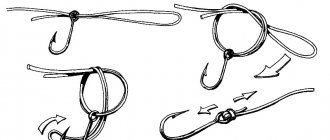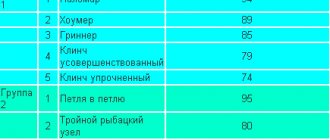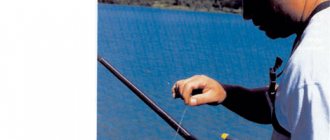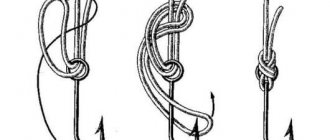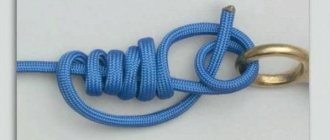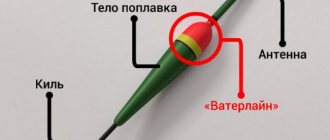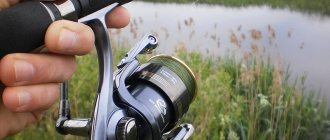A fishing stop is a small thing used by fishermen when preparing various types of equipment.
It seems like a simple object, having miniature dimensions, but its role is not secondary, and sometimes even the main one since it “disciplines” some fishing accessories from the freedom of movement along the length of the equipment. In this article we will give a detailed description of the types and shapes of stoppers for fishing, and reveal the secrets of their use and making them yourself.
Content
- 1. What is a fishing stop
- 2. What types of fishing stops are there?
- 2.1 Silicone stoppers
- 2.2 Thread stoppers
- 2.3 Fishing cambric
- 2.4 Locking units
- 2.5 Homemade stoppers
- 2.6 Installation of ready-made stoppers on a fishing line
- 3.1 Feeder equipment
- 3.2 Sliding float
- 3.3 Stoppers in carp equipment
- 3.4 Stoppers for silicone baits
- 3.5 Stoppers for attaching weights
Stopper knot on the line
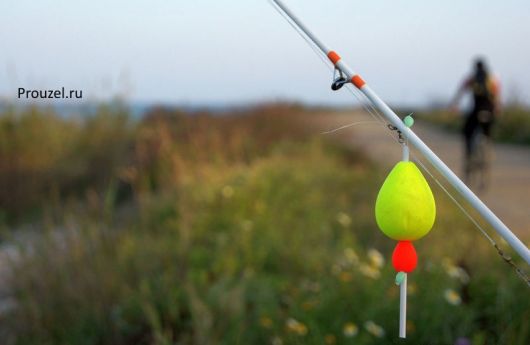
Often you have to fish at a considerable distance from the shore. Throwing conventional float rods (match gear) over a long distance is quite problematic. Simple equipment is not suitable for this.
Another disadvantage of a fixed float is the difficulty of fishing at great depths or from a boat (throwing into windows between the grass). In cases where the depth of the proposed fishing exceeds the length of the existing fishing rod.
In such situations, a sliding float helps out. This type of equipment allows the float to slide freely along the cord, stopping at the place where the stoppers are installed. When casting, the load and leash sink freely. The float moves up to the set depth limit along the fishing line of the fishing rod.
What is a fishing stop
A fishing stop is another accessory, the importance of which is not even disputed by anglers, as it is used in the assembly of many fishing gear.
Why do you need stoppers for fishing? The main mission for which the stopper was invented is to limit the sliding of elements such as a float, weight or fishing leash along a fishing line (monofilament, fluorocarbon, braided, etc.), that is, with the help of this stopper we set the equipment elements to the required amplitude in Their movement along the fishing line is either completely limited in movement and securely secured in the right place.
Stopper function in the equipment chain:
- Pass freely through the rod guides.
- Be fixed to the fishing line so that the nozzle clearly drops to the desired depth.
- Move along the fishing line if the depth of the equipment elements changes.
- Securely attached to the fishing line.
What should a stopper be like for fishing:
- Dense.
- Elastic.
- High quality.
- No external flaws.
These characteristics are important. So, without density, the rubber (silicone) stopper will not hold on to the fishing line and will slip, for example, under the influence of the weight of the float. Elasticity of the stopper is necessary for comfortable movement along the fishing line, so as not to cause unnecessary tension. The quality of the stopper is not an unimportant factor, since this accessory, like other fishing items, is exposed to natural factors such as water, sun, etc. A low-quality stopper, under the influence of sunlight, can simply crumble at the most inopportune moment for the fisherman.
All the most important things about a sliding float: characteristics, shapes, types of fastening, conditions of use, selection rules for long casting and much more, read here
Read and discuss! YOUR OPINION IS IMPORTANT TO US!
Wagler - both float and cannon
Wagler or Wegler? Float or cannon? Let's see where the history of this name takes us!
Fishing next to the balloon and the long-awaited crucian carp of the Moscow region
The Theater of Nature opened its curtain, fishing began and the crucian carp near Moscow, to the accompaniment of frogs, finally deigned to look into the fish tank. This train...
ATEMI rod - a rarity from the early 2000s
I won’t say that I’m a fan of float fishing, but I have a rarity from the early 2000s and I treasure it. Just a few lines about the ATEMI brand and its quality...
Float Wormix 401 models - review of the Russian float
There is no ideal float for any conditions, but since childhood, we have associated fishing with this part of the fishing tackle. We present material about...
Fishing for roach with coltsfoot
Spring time is the most joyful, and spring roach is the most delicious! So, go fishing for spring roach when the coltsfoot blooms. A lot can...
How Waggler floats were born
How Waggler floats were born or the history of the creation of the most common float
Tags: Float Float fishing Rubber stop Silicone stop Fishing stop Stoppers
What types of fishing stops are there?
2.1 Silicone stops for fishing
A silicone (rubber) stopper for fishing looks like a small piece of nipple tube, 3 to 5 mm long, through which a fishing thread is passed (for reliability, you need to pass the fishing line twice). The disadvantage of the tube is that it roughens the equipment and does not slide well through the fishing rod rings. This type of stopper is considered a classic and has been used by fishermen for many years.
A modern version of a fishing stopper is a silicone or rubber retainer, which has various forms:
- ball shape;
- ellipse shape;
- spindle shape;
- cylinder shape.
The disadvantage of cylindrical fishing brakes is their ability to slide along the fishing line, but to fix them at a certain point, anglers attach several of these elements to the fishing line at once.
The choice of one form or another depends on the personal preferences of the fisherman. The only type of installation where the shape plays a role is installation with a sliding float, where the design of the stopper would not allow the float mounting ring to get stuck on it or not slip through the stopper. Such “undesirable” shapes include an oval or a spindle. It is also not recommended to take stoppers with large sizes, so as not to enlarge the equipment, which can lead to overlaps and other inconveniences during the fishing process.
2.2 Thread stoppers
What is a thread stopper or thread stopper and where is it used, read in detail here
Here you can find a selection of the best deals on fishing products we found on the aliexpress website. Thanks to this catalog, you can reduce the cost of installing gear by 2, and sometimes 5 or more times. You will find a detailed description of various products, their characteristics and justification for the benefits of purchasing them. And if you spend 10 minutes and learn how to use cashback, you can additionally save up to 15% on all purchases in a Chinese hypermarket.
2.3 Fishing cambric
You will find detailed information about what a cambric is, what its functions are and how to fish with it here.
Who doesn't know yet? You can return up to 15% of the price of your purchase on aliexpress. In addition to Aliexpress, the possibility of cashback (returning part of the money) also works for many other online stores. Here is a detailed description of this service and everything about how to work with it. It really works and helps you save a lot of money. The cashbacker website often runs promotions that allow you to buy goods at a discount of up to 90%.
2.4 Locking units
If you are planning fishing with float gear, then you should pay attention to this type of fixation of equipment elements.
Float fishing, as one of the types of match fishing, involves the use of a long rod with many small guide rings; they are the ones that stand in the way of the fishing knots to the fishing point.
To avoid such moments, special locking units for the sliding float are used, which:
- Suitable for the size of the tackle rings.
- Necessary for tightening the fishing knot if it becomes loose.
Read about what types of locking knots are used by fishermen and how to tie them correctly here
For all fishing enthusiasts, we also present an article about the most reliable and popular fishing knots, and methods for tying them - here
2.5 Homemade stoppers
A do-it-yourself stopper for a float not only saves money on the purchase of this important small item, but also makes the equipment more reliable, unlike store-bought ones, since it is made for oneself and using reliable materials.
The main material for the future stopper can be a faucet gasket, which, firstly, in this application is durable, secondly, less susceptible to natural factors and thirdly, cheap and available for purchase at any hardware store.
In his short but informative video, Leonid Timo will show you how to make your own stopper for a sliding float quickly and reliably
And here is a device with which you can save silicone stoppers for reusable use, made by yourself from the St. Petersburg Hunter channel
Victor Korobkin in his video will share with you how to use a glue gun to make a silicone stopper for a fishing line and more, with your own hands
2.6 Installation of ready-made stoppers on a fishing line
For the convenience of moving the stopper from line to line, as well as storing this “braking device,” manufacturers have created stoppers on wire loops, the so-called “line” stoppers. Thus, even a beginner will figure out how to drag the stopper from one fishing line to another using such a useful invention as a factory loop. To do this, you need to thread the factory eyelet into the eye, on which the stopper is attached to your fishing line, and pull the stopper along it.
This process is shown in detail in this video (channel “SIRIUS 17”)
During the fishing process, a line break may occur, and as a result, all the stoppers will be lost, but if the loop of the only remaining stopper has fallen out, and the fishing process is in full swing, then it’s not a problem. To eliminate this problem, you will need a sewing needle, insert a thin piece of fishing line folded into a loop into the eye of which and pull the needle along the body of the stopper. The new stop eye is ready.
On store shelves you can also see a factory-made locking knot (usually complete with beads that prevent the locking knot from being hit), but not in a tightened form. The installation of such a stopper on a fishing line is similar to that described above, but with the difference that instead of a loop that leads onto the fishing line, a tube is used, onto which the knot is pulled together and clamped. The disadvantage of this type of fastening of the stopper is the unreliability of the unit, since it tends to weaken and requires constant tightening.
Common Stopper Knots
Duncan knot
| Wraps the long part around the main line, the short end (4-6 turns). |
| The running end is inserted into the initial loop. |
| The knot is wetted, carefully tightened and a knot is formed. The ends are trimmed, leaving a couple of centimeters on each side. |
| Take a piece of thread (cord) about 30 cm in size. The diameter should be equal (slightly larger) to the main one. |
A loop is made, one tip is larger (5cm).
Stop Clinch
“Clinch”, this quick-cooking stopper, is performed:
| Leads to the base. The long edge is passed under the fishing line and wound into a loop. |
| Wraps four times around the warp and thread, and threads through the loop. |
| The knot is wetted and tightened, holding the short part. |
| A piece of 25-30 cm is applied to the fishing line. |
| At least four turns are made around the short end and the main material. |
| The long part is passed into the loop formed on the fishing line and tightened. |
To save time on fishing, you can tie knots at home in advance.
You will need: a cocktail tube and a cord (preferably sewing thread).
Where are fishing stops used?
3.1 Feeder equipment
One of the important points in feeder fishing is not to miss a bite, and this is sometimes problematic, since heavy feeders are used in feeder fishing. In order to catch the most delicate bite, you need to equip your fishing rod with sensitive equipment, which means you need to use a shock absorber in the form of an elastic band. To prevent the shock absorber from stretching in the feeder equipment, it is fixed to the fishing line with a silicone stopper or cambric.
3.2 Sliding float
This question is written in a very detailed and informative manner in the instructional article here
3.3 Stoppers in carp equipment
In carp fishing, fishing stops take an active part, especially in hairline installation.
Silicone stopper (of any shape), which is attached to one side of the fishing leash. Its function is to fix the bait and prevent it from moving towards the carp hook. Otherwise, the installation will not be effective. Then the boilie placed behind the stopper is fixed with another, special stopper.
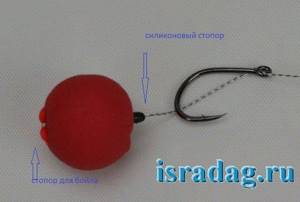
The article is devoted to one of the types of fishing hooks intended for carp fishing, its features and advantages are described, the types of carp hooks are considered and advice is given on their selection and use when fishing for carp, read here
Stoppers for boilies are:
- for solid (hard) boilies with thin “petals”;
- for soft baits - with large petals that prevent the stopper from entering inside the boilie;
- floating stoppers with a hook, which give the nozzle neutral or positive buoyancy;
- stoppers, shaped to imitate corn kernels with hooks that are mounted in the boilie.
- maybe a stopper of this shape.
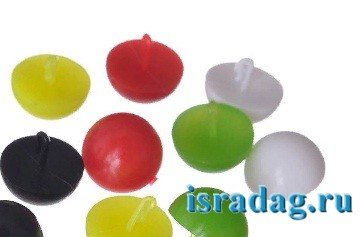
All stoppers have different shapes and bright colors that match the color palette of the boilies and serve as an appetizing beacon for fish. The size range is also varied. Manufacturing material – plastic.
Every fisherman can make a stopper for boilies with his own hands using a small piece of plastic tube. An empty ballpoint pen, a piece of rubber, or even a thin elastic band, which is used for tying money, can also serve as a stopper.
It is also worth mentioning the role of the stopper in other aspects of carp fishing. These small accessories can also serve well in attaching a leash to a carp hook, where corn grains are strung onto the left leash tail, which are secured with the same silicone stoppers: at the bottom with special carp ones, and at the top with rubber ones.
How to tie a stop knot on the main line
A sliding float is quite often used in fishing with float rigs at long distances. The technique of this method allows you to catch cautious fish in deep areas of reservoirs. The principle of forming this kind of equipment requires the fisherman to be able to use stoppers that affect the length of free movement of the float along the main thread. Currently, rubber or silicone restraints can be purchased at a fishing store, or you can learn how to knit stopper knots yourself by mastering a number of simple and quickly memorized patterns.
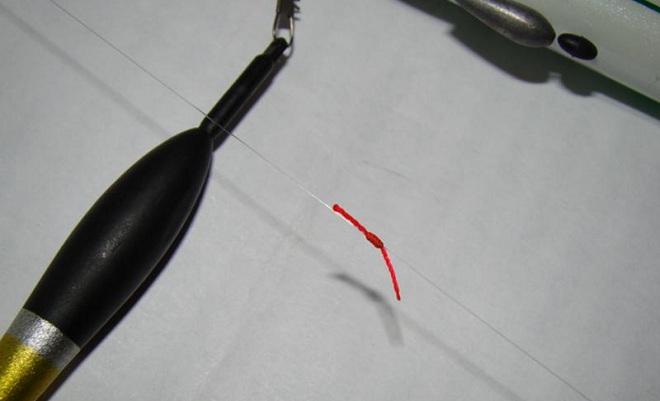
In the article presented to the reader, the secrets of self-knitting three options for the most common types of locking knots will be revealed. In addition to the tying technology, the fisherman will be explained the principles of operation of this, albeit small, but quite important element of equipment, which affects the performance of the installation with the presence of a sliding float in its composition.
Color of fishing stops
Now in stores you can see a variety of color solutions for stoppers. Most fixing elements are black, light coffee or transparent. Such colors are considered the most acceptable, since they do not attract prey in the water and thus do not distract prey from the bait used.
The use of colorful brakes must be justified. For example, red color can be used when fishing on a reservoir with a clay bottom, green - in a reservoir rich in vegetation, yellow color - in a reservoir with a poor sandy bottom.
What to make a stopper assembly for a float from?
You can make locking units yourself from the following materials:
- cord used in fly fishing;
- wicker materials;
- monofilament fishing line;
- ordinary textile threads.
Cord, braid - passing well through the rings, visible on the main line. Monofilament, less noticeable. If the knot is tightly tightened, deformation of the main material of the tackle will occur. Therefore, making knots out of it is not recommended.
The most suitable stopper for a float is a thick thread. It does not come undone when wet, and has excellent adhesion to the main line.
The thread is chosen to be of equal diameter to the warp. Any color can be used. Bright colors will always help you easily find the place to install the stopper.
How they work
As a rule, rigs with sliding floats include a pair of stoppers. The first of them is installed on the main line in front of the float. The second clamp is mounted behind the signaling device, almost right next to the sinker. It prevents the heavy float from coming into contact with the load, which occurs as a result of casting the rig on the backswing and during the flight of the equipment. When casting, the float moves toward the end of installation, and the stopper prevents tangling of equipment elements, stabilizing the position of the alarm, thereby increasing the aerodynamics and flight qualities of the equipment.
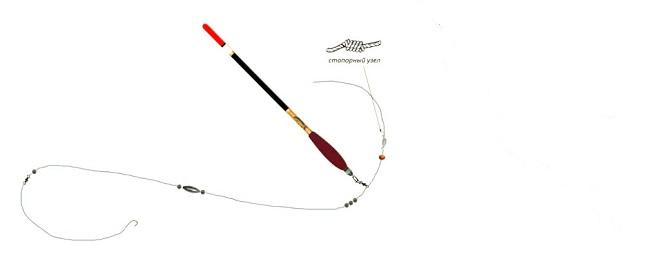
The upper stopper comes into operation after splashdown of the installation, which entails immediate, under its own weight, deepening of the load with bait. The stopper on the fishing line will stop the float rising upward along the thread at the mark required by the fishing conditions and will reliably hold the installation in the required water horizon. To change the horizon of setting the equipment or the depth of the bait, the angler needs to move the limiter along the line in one direction or another and calmly continue fishing.

